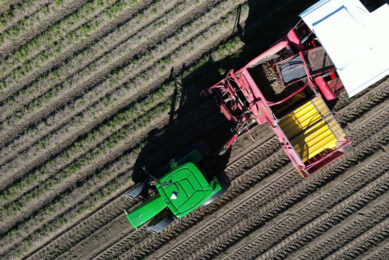How farmers benefit from an oilseed rape disease sensor

Sclerotinia can be a devastating disease affecting oilseed rape (canola) crops around the world, which the Canola Council of Canada says results in yield losses of 50% or more. A sensor seems to be a breakthrough.
The challenge in managing sclerotonia has always been the variability in incidence between years, regions and fields and knowing when to treat crops.
However, this problem may soon be solved thanks to a breakthrough in disease detection made by researchers in Alberta, Canada. The discovery means it will soon be possible to get an early warning of the presence of disease inoculum.
In addition, this advanced notice will be automatically sent to a designated mobile phone, so that growers simply receive a text message alerting them to the threat of a disease outbreak.
As such, use of the biosensor in the field offers a method of improving the timeliness of spray applications – without having to go out and check the crops.
Highlights:
– Sensor based on medical technology
– Detects presence of sclerotinia spores
– Alerts farmers by mobile phone
– Available within 2 years
Sensor in 2 years
After initial success with the prototype, the Canadian research team is confident it has all the parts in place to get an in-field system on the market in the next couple of years.
Lab tests have already shown how effective the biosensor is at picking up the spores and then sending an alert to a mobile phone, with further tests now being planned for field situations.
According to Susie Li, senior research scientist with InnoTech Alberta, real-time in-field disease monitoring is very near to being an affordable reality.
This is because the signals received from the biosensor when spores have been found can be processed electronically and converted into sharable data, such as an iPhone message.
See also: Managing sclerotinia in oilseed rape academy
Mobile alert
“It’s not just about being able to pick up the relevant spores in the field,” Li explains.
“It’s also bringing in a communication element and getting the information across to growers in a rapid and concise format, so they can take any necessary action.
“We all know timeliness is of the essence where diseases such as sclerotinia are concerned. It is also applicable to blackleg.”
Blackthorn Arable
Sclerotia in close-up. Photo credit: Blackthorn Arable
Control over spray timing
For growers with land some distance away from their main farm base, this development will have obvious appeal. But it’s also likely to be helpful in taking the guesswork out of spray timing, something that has always been an issue with sclerotinia control.
While very good control can be achieved from a single, well-timed spray application, the protectant nature of the fungicides available for sclerotinia makes the timing critical for success, as it means any fungicide must be applied before infection.
3 factors have to be present simultaneously for infection to occur:
– Airborne disease inoculum
– Petal stick
– The right weather
With the biosensor, the first of these can be ascertained as it starts to build in conducive conditions, with the other two being far easier to determine with existing on-farm technology and systems.
How the sensor works
At the heart of the biosensor is a chip measuring 3.5×2.5cm, which was originally designed for use in the medical profession, analysing DNA or proteins. By applying sclerotinia antibodies to the sensor, it can single out the target antigen – which in this case is sclerotinia spores.
Research done in a growth chamber has shown the device can detect as few as 5 sclerotinia spores, reveals Dr Li.
Next: field testing
“The next stage is to connect all the links and do some field testing – with further work needed to verify the correlation between spore counts and a disease outbreak, as well as how many sensors would be needed to accurately report sclerotinia pressure for a given area.”
As far as costs are concerned, there is no reason why the components shouldn’t be affordable. Each chip used for the sensor costs only US$10 (£8) – so the final bill will depend on how many chips are needed for the field.
“It’s not as expensive as people think. The technology already exists”, she says.
Join 17,000+ subscribers
Subscribe to our newsletter to stay updated about all the need-to-know content in the agricultural sector, two times a week.



